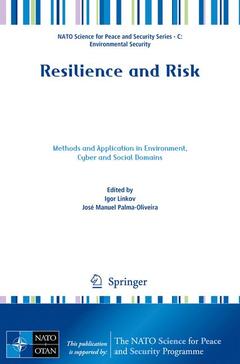Description
Resilience and Risk, 1st ed. 2017
Methods and Application in Environment, Cyber and Social Domains
NATO Science for Peace and Security Series C: Environmental Security Series
Coordinators: Linkov Igor, Palma-Oliveira José Manuel
Language: English
Subjects for Resilience and Risk:
Resilience and Risk
Publication date: 08-2017
Support: Print on demand
Publication date: 08-2017
Support: Print on demand
Resilience and Risk
Publication date: 08-2017
Support: Print on demand
Publication date: 08-2017
Support: Print on demand
Description
/li>Contents
/li>Comment
/li>
This volume addresses the challenges associated with methodology and application of risk and resilience science and practice to address emerging threats in environmental, cyber, infrastructure and other domains. The book utilizes the collective expertise of scholars and experts in industry, government and academia in the new and emerging field of resilience in order to provide a more comprehensive and universal understanding of how resilience methodology can be applied in various disciplines and applications. This book advocates for a systems-driven view of resilience in applications ranging from cyber security to ecology to social action, and addresses resilience-based management in infrastructure, cyber, social domains and methodology and tools. Risk and Resilience has been written to open up a transparent dialog on resilience management for scientists and practitioners in all relevant academic disciplines and can be used as supplement in teaching risk assessment and management courses.
Part 1: Introduction.- Chapter 1. An Introduction to Resilience for Critical Infrastructures (Igor Linkov).- Part 2: Methods.- Chapter 2: Towards a generic resilience management (Ivo Häring).- Chapter 3: Redesigning Resilient Infrastructure Research (Thomas P Seager).- Chapter 4: Designing Resilient Systems (Scott Jackson).- Part 3: Infrastructure.- Chapter 5: Infrastructure Resilience Assessment, Management (Hans R Heinimann).- Chapter 6: Engineering Resilience in Critical Infrastructures (Giovanni Sansavini).- Chapter 7: Seaport Climate Vulnerability Assessment at the Multi-Port Scale (Robert McIntosh).- Chapter 8: Resilience of Critical Infrastructures (Paolo Trucco).- Part 4: Social.- Chapter 9: Social Resilience and Critical Infrastructure Systems (Benjamin Trump).- Chapter 10: Societal Resilience: From Theory to Policy and Practice (Meir Elran).- Chapter 11: Planning Resilient Communities (Alexander Hay).- Chapter 12: Integration of Risk and Resilience into Policy (Charles Baubion).- Chapter 13: Realising critical infrastructure resilience (Jon Coaffee).- Part 5: Cyber.- Chapter 14: Bridging the Gap from Cyber Security to Resilience (Paul Roege).- Chapter 15: Cyber-Transportation Resilience (Maria Nogal).- Chapter 16: Resilience and Fault Tolerance (Niels P. Zussblatt).- Part 6: Applications.- Chapter 17: Building Resilience through Risk Analysis (Philip O'Neill).- Chapter 18: Enhancing Organizational Resilience through Risk (Dalila Antunes).- Chapter 19: Integrative Education Model for Resources (Dejan Vasovic).- Chapter 20: Valuation of Imminence Analysis (Eugene Piechoczek).- Chapter 21: Resilience needs in NATO Partner Countries (Ahmed A Hady).- Chapter 22: Contribution to Enhancement of Critical Infrastructure (Branislav Todorovic).- Chapter 23: Risk and Resiliency Assessment of Urban Groundwater Supply Sources (Zorica Srdjevic).- Chapter 24: Simulating Reservoir System Operation Under Given Scenarios (Bojan Srdjevic).
Highlights similarities and differences of risk and resilience across multiple domains and applications Provides an open and transparent dialog of current challenges being faced in the field of risk and resilience today, identifies gaps and possible solutions Provides a clear argument for the necessity of a systems-driven view of resilience across a variety of applications, ranging from cybersecurity to ecology to social action
© 2024 LAVOISIER S.A.S.




